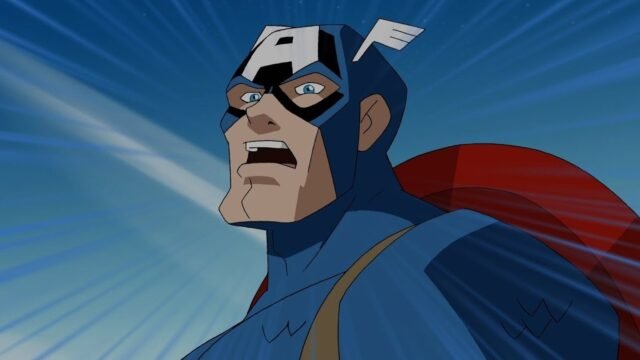“Captain America” was being developed by cartoon veteran Will Meugniot, his wife Jo and storyboard artist Dave Simons. The series would have been set during World War II, as you can see in one part of the project that was completed: a one-minute promotional video.
https://www.youtube.com/watch?v=sd7vinvtfiw
The trailer shows a version of Captain America’s origin story where the tail-strapped Steve Rogers becomes a muscle model thanks to the super soldier serum. But is that Steve Rogers? According to most reports about the show, Captain America’s real name was Tommy Tompkins. “Steve Rogers” was an alias the military gave him as a cover. A puzzling choice, but a sure thing!
The promo’s animation style resembles the 1999 cartoon “Spider-Man Unlimited” (which Saban and Meugniot worked on), with shading and proportions to suggest a comic book brought to life. Appearing in the trailer are Cap’s sidekick Bucky and at least some of the Howling Commandos, as well as his enemies the Red Skull and Baron Wolfgang von Strucker.
One of the show’s writers was reportedly Steve Englehart, the “Captain America” comic book writer who had Cap fight Prescher Richard Nixon in 1974. Englehart publicly shared a synopsis for an episode he wrote, “Skullhenge,” about the Red Skull trying to rearrange the Stonehenge formation in England into a giant swastika.
The choice to set “Captain America” in World War II makes sense. Cap was created by Jack Kirby and Joe Simon in 1940, months before the U.S. entered the war. Kirby and Simon drew a flag-waving, Führer-punching American hero. Captain America has also struggled when removed from a war scenario; in those instances, he can sometimes feel like just another superhero. The best modern “Captain America” writers, like Englehart, have used this discomfort to contrast Cap, the idealized warrior of the greatest generation, with the reality of America, but I digress.
But there’s a problem with the World War II setting. According to Englehart, the show wouldn’t be allowed to call the bad guys “Nazis.” Apparently, that was a bit of a stretch for a kids’ show. This isn’t without precedent. The ’90s “X-Men” sanitized Magneto as a Holocaust survivor, depicting him as just a generic refugee. The sequel series “X-Men ’97,” aimed at the same but now older audience, had to correct Magneto’s origin. Even “Avengers: Earth’s Mightiest Heroes” (which premiered in 2010) shows the Allies fighting Hydra and only Hydra during World War II.
Over the years, there have been rumors that this issue was what kept the show from getting off the ground, but comic book historian Brian Cronin disputes that . Englehart and Cronin attribute the cancellation of “Captain America” to money troubles that Marvel was facing at the time; they filed for bankruptcy in 1996, having been caught in a major crash during the comic book boom of the ’90s. The effects of these financial struggles are shown in how abruptly this era of Marvel cartoons ended. In 1998, “X-Men” and “Spider-Man” ended, and “Silver Surfer” and “Spider-Man Unlimited” ended after just 13 episodes. “Captain America” never got an episode.
These days, Marvel fans can debate which canceled/early ’90s cartoon they’d rather have seen more of: Meugniot’s “Captain America” or Mike Mignola’s “Thor.”














